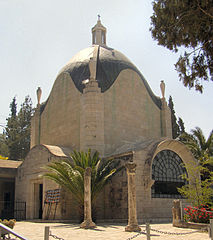Dominus Flevit Church


Dominus Flevit Church is a Roman Catholic church on the Mount of Olives, opposite the walls of the Old City of Jerusalem. The church was designed and constructed between 1953 and 1955 by the Italian architect Antonio Barluzzi and is held in trust by the Franciscan Custody of the Holy Land. During construction of the sanctuary, archaeologists uncovered artifacts dating back to the Canaanite period, as well as tombs from the Second Temple and Byzantine eras.
History
Dominus Flevit, which translates from Latin as “The Lord Wept”, was fashioned in the shape of a teardrop to symbolize the tears of Christ. Here, according to the 19th chapter of the Gospel of Luke, Jesus, while riding toward the city of Jerusalem, becomes overwhelmed by the beauty of the Second Temple and predicting its future destruction, and the diaspora of the Jewish people, weeps openly (an event known as Flevit super illam in Latin language). (Luke 19:37-42)
The site of Christ’s weeping was unmarked until the Crusader era. It was during this time that people began commemorating the site. Eventually a small chapel was built there. After the fall of Jerusalem in 1187, the church fell into ruin. In the early sixteenth century a mosque or madrasah existed at the site, presumably built by the Turks, from the remains of the earlier church, although the exact use is disputed. This place was known as el Mansouriyeh (The Triumphant) and also el Khelweh (The Hermitage).
The Franciscans were unable to obtain the ruins, so, in 1891 they purchased a small plot of land nearby and built a small chapel there. In 1913 a small private home was built in front of the Franciscan chapel by one Miss Mellon. This home eventually passed to the Sisters of St. Joseph, who eventually sold it to a Portuguese woman.
Byzantine mosaic
The Byzantine mosaic floor, dating to the beginning of the seventh century A.D. The floor surrounded by ribbons and waves motifs. The center of the carpet divided by squares inhabit round frames. The circles inhabit fruits, vegetables, flowers and fish. Dominus Flevit Byzantine mosaic attest to the importance of agriculture for the people of the period. The motifs reflect a developed and progressive agriculture of the time, from Israel and Jerusalem. Some models also designed as a unique description. For example, Luffa for the producing of bathing sponge, edible Snakes Melons, and figs tied by a blue string.
Source : wikipedia
https://www.youtube.com/watch?v=Qr28ANeowHg
https://www.youtube.com/watch?v=wc4od2IshlY
https://www.youtube.com/watch?v=2HLpSPFQqFo
Reviews
https://goo.gl/W4tQx9


Rate this article